Automatic pump for increasing water pressure. Water boost pump
The main purpose of booster pumps is to create optimal pressure in plumbing, heating and sewage systems. In suburban homes with several floors, and equipped with autonomous systems and modern household appliances, units that increase pressure cannot be dispensed with. Boost pumping equipment is available exclusively with a wet rotor. This arrangement ensures the noiseless operation of the device and increases the period of trouble-free operation.
Even the simplest models of equipment are able to provide a water pressure sufficient for the trouble-free operation of household appliances in the house, as well as the circulation of the coolant in heating systems.
Pumps to increase the pressure of water in the house
- with manual control.
- automatic.
Manual control allows for continuous operation of the device, while shutting down is also done manually. Automatically controlled models have flow sensors that trigger when the tap is opened and turn on the unit. At the moment of blocking the flow, the sensor switches off the unit. In addition, this equipment can be of horizontal and vertical type.
How to choose a boost pump
Having decided to buy a booster pump, pay attention to its advantages:
- the ability to work with environments whose temperature varies from -15 ° C to + 100 ° C. However, in order to extend the life of the device, it is recommended to use it at a temperature not exceeding + 40 ° C. low noise, compact size and light weight;
- low power consumption (for models with automatic control);
- connection directly to the pipeline;
- convenience of service.
When choosing a device, special attention should be paid to such parameters as power, performance, noise level and the maximum possible pressure. Boost pumps are available at an affordable price. Moreover, they can be of a universal type or strictly specialized: devices for water, equipment for wells, circulating hot water supply, circulating, drainage and fecal aggregates and stations.
Booster pump must be present in any water supply system, especially when it comes to cases where the pressure is critically low or there is no centralized water supply. A pump for pumping water pressure allows you to fully use household appliances (washing machines and dishwashers) and, in general, make full use of water on the upper floors of high-rise buildings. However, such equipment is in great demand in the private sector, as well. hot water improves the efficiency of the heating system. In this article we will consider all questions regarding the selection and installation of booster pumps.
The problem of low water pressure in the tap is familiar to many residents of high-rise buildings and private houses. This is especially noticeable in winter, when the batteries on the ground floors cannot be touched, and in the apartments upstairs they are barely warm, not to mention the hot water from the tap. And if a washing machine or dishwasher is installed in such an apartment, there are problems with their work - because of the low pressure of the water, they simply do not turn on. There are several ways out of this situation - to look for more convenient housing or to install a booster pump for water. Naturally, the second option is cheaper and more practical, but before you run to the store for the device, you should understand how it works.
The pump pressurizes the water pipe, bringing it closer to a comfortable norm - close to 4 atmospheres. In most cases, in high-rise buildings, this indicator stops at about 1-1.5 atmospheres, so it is not surprising that washer simply refuses to turn on, because for its operation, a pressure of at least 2 atmospheres is necessary. Today, many change bulky bathtubs to compact and multifunctional showers, and then they wonder why they do not meet the declared characteristics - they lack water pressure. However, one should not strive for excessive pressure increase. With an indicator of 7 atmospheres, the pipes may not withstand, especially if the apartment is in a Soviet-built house. It is enough to create the same norm in 4 atmospheres in order to fully enjoy all the benefits of a water supply system.
There are a lot of varieties of household boosting pumps, and it will be difficult for an ignorant person to choose the right option. Models differ in control method, water temperature and cooling method.
Classification by control method:
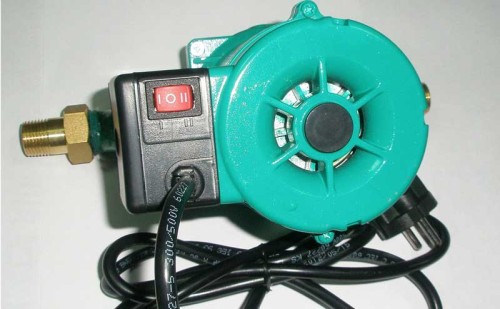
Booster pumps for water supply should be selected depending on which water you want to pump - cold or hot. There are pumps specifically for cold, hot water or mixed type (universal). You can not use the apparatus to increase the pressure of cold water for "hot" pipes, otherwise it will quickly fail, because its parts and coatings are not designed for such operation. Universal devices are convenient in that they can be used for any pipes, but the price of a booster pump of this type will be higher than a narrow-profile one.
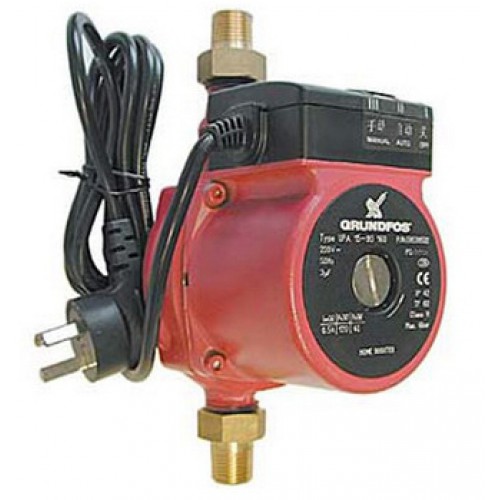
Even if the pump is pumping cold water, it can overheat, so each device has its own cooling system. Some models are cooled by the water flowing through them, but in this case there is a risk of overheating in the absence of water in the system. There is another option - dry rotor cooling. Such pumps have a shaft with blades, the rotation of which blows around the motor and cools it. The first models "on the water" work almost silently, but require constant monitoring, while the second emit a strong hum, but are more productive.
Good to know: To reduce the noise level of models with a “dry rotor”, this same rotor is located in the pumped water, turning the device into a device with a “wet rotor”.
Self-priming pump station
Living in the city is very convenient, but as practice shows, this is not always the case. In many old-built houses, the pressure of water is very weak, and residents of apartments on the upper floors rarely boast a good pressure of tap water or heat-radiating central heating batteries. Many solve this problem by installing a self-priming pump station. The principle of operation of the booster pump is simple: it pumps water into a small tank, from where it, under predetermined pressure, goes to the shower stall, washing machine, gas boiler and other water points. To set the desired pressure, you must use a special relay.
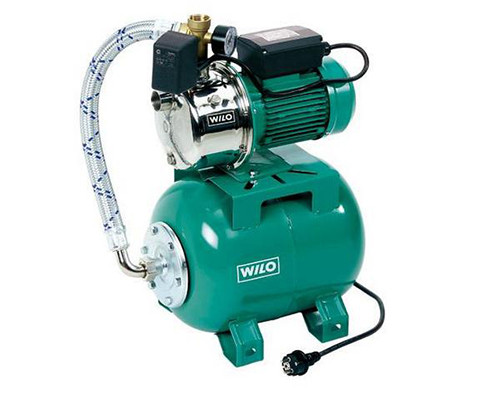
Useful advice: There are self-priming stations on sale without batteries, but it’s better to pay a little more and buy a pump with an accumulating tank. The larger the volume of this tank, the longer and more efficient the equipment will last, since it will not be necessary to turn on the transfer pump too often.
When the pump pumps water into the storage tank, the device turns off. But there is water in the tank, therefore, it can be used even if the water supply system is completely empty (the water was turned off due to an accident, for example), which, you see, is very convenient.
Before you purchase a station, find out the maximum possible water pressure that it can dispense. For example, the Grundfos JP Booster 6-24L is designed for a maximum pressure of 48 m, and a large tank of 24 l will allow you to comfortably wait out any accident or other unplanned shutdown of water.
How to choose a pump
So, we have already found out that pumps can significantly improve the life of a city dweller, however, what criteria should be followed when choosing?
What questions should be asked to the sales assistant in the store:
- What is the power of the pump - it is clear that the more powerful the device, the better, but you still should not bend the stick, especially if the house has old pipes. First you need to measure the current water pressure in the water supply (buy a manometer), and only then set a higher frame. When determining power, it is also necessary to consider the number of taps and plumbing equipment.
- Whether the pump is very noisy - we have already found out that pumps with “wet” cooling with flowing water work almost silently, and with a “dry rotor” they can cause discomfort to residents.
- Whether the model is suitable for the cross-section of pipes in your apartment - some pumps are designed for a certain cross-section of pipes, so it is not out of place to measure this figure before going shopping. If you install a pump with the wrong cross section, it will experience overloads and the water pressure will not increase.
- To what height should the water be raised - if you choose a pump that is too weak, it simply will not catch up with the water to your floor.
- If the installation will take place in a small room, the size of the pump should be appropriate.
- And lastly, one hundred should pay attention - the reputation of the manufacturer and the availability of a quality certificate.
Manufacturers Overview
Almost all domestic pumps are compact, which makes it possible to place them on a pipe in any apartment or private house without problems. At the same time, most models provide only an insignificant increase in pressure, but usually this is enough for the head to improve the operation of equipment and the movement of hot water in the batteries.
Useful advice: It is best to choose pump models from well-known manufacturers specializing in the production of this particular equipment. That is, if the company produces pumps, mobile phones and pillow covers, it is better to look for something else.
We will consider the products of the most popular manufacturers, presented on the domestic market:
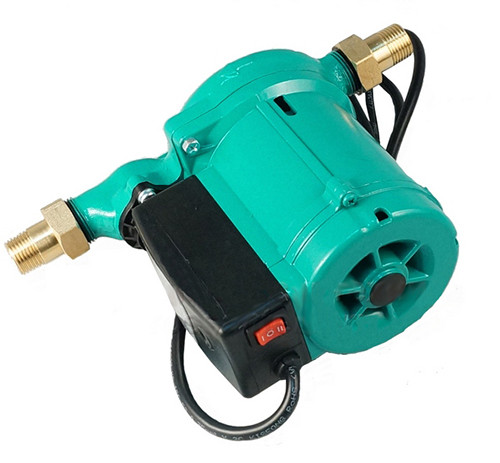
Pump installation
The installation location of booster pumps is very important and determines the efficiency of their work. The flow sensor can be triggered to turn on only if water flows through the pump, therefore, to supply water to the first or second floor, the device should be installed in the basement. At the same time, full-fledged work is possible only in a complex installation with another pump, which will ensure the rise of liquid through the pipes.

The working circuit of the booster pump is easy to understand and will help to install the unit correctly. The discharge device must be mounted on the pipe in front of the water intake points, so that with a low pressure it can turn on and supply water to all consumers. When you start one of them (turn on the washing machine or open the faucet), the water moves, and the flow sensor instantly responds to this movement, including the pump (usually it takes no more than a second). If you live on the 4th-5th floor and install the pump in the basement, then its capacity will not be enough to raise the water to the desired height.
![]()
Connection diagram of booster pump:
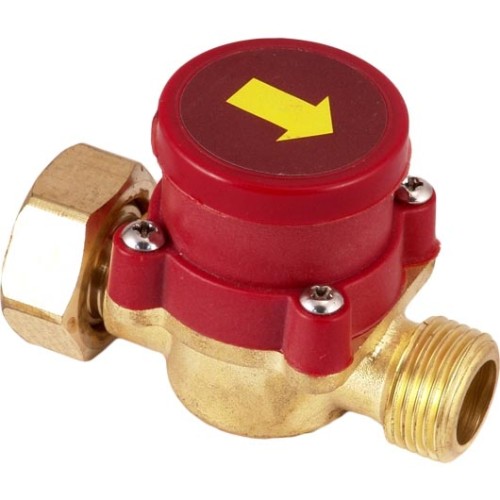
As you can see, the installation scheme of the booster pump is not so complicated, but to do everything right, you need to have minimal locksmith skills - be able to cut pipes and make threads.
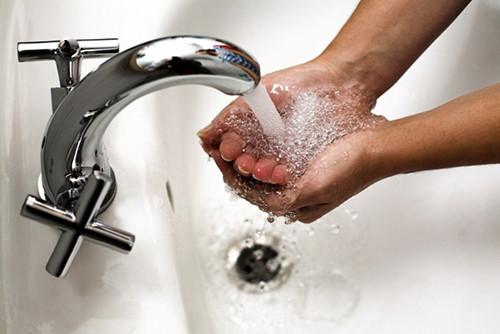
In order for the pump to serve you for many years, follow the following rules during installation:
- In order for the pump to work longer, it is advisable to install it at the inlet mechanical filter. In the city, the water is rather dirty, and the pipes are mostly old with perennial deposits on the inner walls, so it would be a shame if a piece of hard coating accidentally come off the pipe gets into a new pump and spoils it.
- Install the pump in a dry, heated room. If the temperature drops below zero, the water inside will freeze, and the device will fail.
- Installation of the stopcock must take place to the point of installation of the pump, so that if necessary, carry out preventive work, blocking the access of water.
- Any, even the most silent pump, vibrates during the operation, and this vibration can violate the stability of the device over time - loosen it. So get used to checking the strength of the fasteners from time to time and tightening them if necessary.
A pump forcing water pressure can significantly improve the quality of life in a city apartment or private house. Let it be necessary to invest a little money and spend a little time for this, but in the first winter you will experience dramatic changes - it will become warmer in the rooms, and hot water will flow from the tap immediately, and not after 5 minutes of waiting.
The problem of lack of pressure in an autonomous water supply system is not uncommon. Often this comes from incorrectly selected equipment with mandatory storage tank at the highest point - in this case, water flows by gravity. The system is suitable for a summer residence, however, to meet the needs of a residential building - it is absolutely not rational. Pressure is not enough even for hygiene needs, not to mention the amount of equipment requiring water. In this case, experts recommended a booster pump for the water supply, which increases the pressure in the system.
Types of booster pumps - which one to choose
The device is an assembly designed for tapping into a system to increase existing pressure. The range of the parameter is from 1 to 3 atm. The classification of these products is as follows:
- Type of cooling. Dry and wet rotor. The first unit is characterized by high performance, however, noisy. The second for numerous needs is ineffective, quite acceptable in summer gardening - watering, outdoor shower, bathhouse.
- The method of inclusion. Automation and manual mode. Naturally, the first option is preferable. It is equipped with a flow sensor that monitors the operation of the device. In manual mode, you will have to monitor the heating of the pump. There are also combined models that allow, first of all, to save electricity during short-term starts.
- Installation Horizontal, vertical, in any plane. The one whose position is suitable for the water supply section is selected.
- Speed. Multistage models allow you to smoothly increase the pressure in the network.
- Type of construction. Compact In-lines work on any part of the water supply, but at the same time they are low-power, which will affect productivity. Vortex models are noisy, require special piping, but at the same time provide the proper level of comfortable use of the water supply.
- The material of manufacture. Traditional cast iron and stainless steel. The first is fragile, sensitive to water hammer and temperature changes, if the pump will be used for hot water. The second is not cheap. Impeller material also matters - plastic is suitable for seasonal summer cottage needs, bronze and brass - for residential.
Based on the classification, a choice is made. As a rule, for cottages they acquire compact built-in units with low productivity and one speed. For a residential building requires something significant.
Specifications
Almost always, the specifications given in the instruction manual indicate the maximum value. To determine the real parameters, the values \u200b\u200bare divided into one and a half, two times. Then they make a choice in favor of a particular unit.
In detail:
- Maximum working pressure. Actually, for what the unit is bought. For giving 2 bar is enough. A residential building often requires more than 3 bars, but since the pumping equipment of a residential building is more powerful than a country house, this value is enough.
- Maximum feed. The bigger, the better. Measured in l / min or cube. m / hour. For watering or a summer shower, an acceptable figure of 1.8 cubic meters. m / hour. For the needs of the house, the parameter is carefully calculated.
- Maximum head. Regarding the well, the main work will be done by the downhole equipment, but it remains to bring the resource to the house, and they are often in two floors. Therefore, take into account the total height from the basement.
- Circuit. Pumping equipment requires an uninterrupted source of electricity. If the home network is replete with frequent interruptions, it makes sense to think about purchasing additional equipment that stabilizes the work.
- Flow rate. The parameter indicates the operation of the equipment after the pressure will drop by the indicated value. Smaller values \u200b\u200bwill indicate a better model - the pump will begin to make up for the loss with minimal drawdown.
- Maximum and rated power. The value of the parameter is understandable - the higher the indicators, the better the pressure will provide a booster pump.
- Water temperature. The range from 2 to 100 C characterizes the model as universal, suitable for a residential building. Cold water supply is often required in seasonal dachas - an outdoor shower is provided by an electric water heater or collector.
- Inlet and outlet diameters. It is important to know in advance the connection area of \u200b\u200bthe unit, then choosing identical values \u200b\u200bwill be easier. Otherwise, flanges are used during installation.
The booster pump, which is most suitable for its object and source of water with its technical characteristics, is considered reliable. For the choice, the model and the manufacturer matter. Let's see what they offer:
Top 5 boosting pumps for home and garden
The Russian market is able to provide consumers with a wide selection of pumping equipment. Among the models there are budget and designed for high requirements. The following have gained popularity:
Booster pump Termica TL PI (Aquatic)
The cost is 3,700 rubles, which is easy for owners of a summer residence. The model is powered by a 220V home network. The maximum pressure of 10 m, the temperature of the medium can increase to 60 C. Consumption of 1.5 cubic meters. m / h allows you to provide all cottage needs.
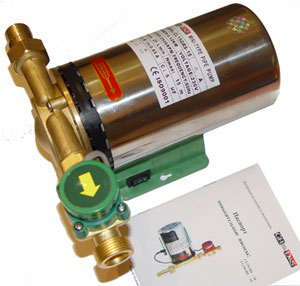
Jemix Booster Pump
In addition to giving it is used for an apartment network. This is especially important for owners whose meters are located above the fourth floor. Standard food, but an uninterrupted power is required - if we are talking about an apartment. maximum temperature - 110 C, pressure 18 m. Price - 5600 rubles.
Grundfos Booster Pump
Leaders in pumping equipment. The price of 13 thousand rubles is most likely due to the brand, since some characteristics are inferior to inexpensive analogues - a pressure of 9 m, a flow rate of 1.8 cubic meters. m / hour. The model uses cast iron and stainless steel, which makes the pump durable. A substantial warranty is 2 years.
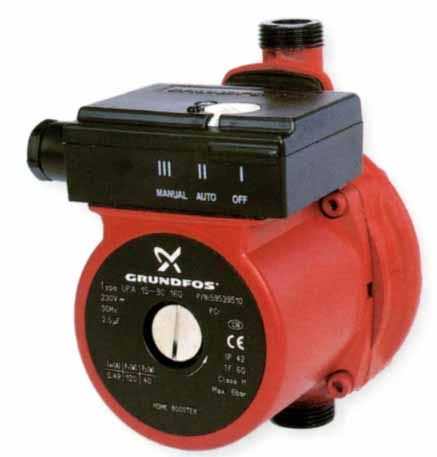
Booster Pump E.SYBOX
Italian manufacturer of pumping equipment for private residential buildings, cottages, production. Naturally, the characteristics are high: productivity - up to 5 cubic meters. m / h, head - 50 m. Lower carrier temperature - 40 C. The average cost is from 35 thousand rubles.
The pump for own needs is carefully selected. Overpay for functions that turn out to be unclaimed in the country - it makes no sense. For a house or apartment, on the contrary, a more powerful unit is required, otherwise what is the point in a working pump if it is not able to squeeze the required amount of water "uphill"?
Where to install the booster pump in the water supply system
To begin with, the installation scheme is thought out depending on the number of equipment and points of drawdown. As a rule, the pump is installed in front of household appliances or a boiler. For trouble-free use of water in the bathrooms, the installation location will be behind the storage tank. The pump does not do without a bypass - a bypass line. The unit serves to increase the existing pressure, and does not replace a completely circulating pump.

Connection is easy:
- At the insertion point, a water pipe is dismantled.
- The booster pump is installed using flange or coupling connections, of course, using a seal - rubber rings, tape-fum and other things.
- A bypass with a ball valve is welded on the same line.
Weak water pressure in the tap can occur for various reasons. In addition to clogged filters and pipes, this can be a decrease in pressure in the system. This is especially true of private households during busy hours. Boost pumps for water supply can effectively solve this problem. With their help you can support optimal system pressurewater supply and provide comfortable operating conditions for showers, washing machines and dishwashers, boilers, etc.
The principle of operation of the booster pump for water supply
Boost pumps for water supply are a single structure consisting of elements such as pumps and electric motors. All parts of the applied equipment are made of high quality materials (cast iron, stainless steel, brass, ceramics) and are highly resistant to corrosion. The pump casing is hidden under water, where the front suction and radial feed sockets are additionally located. Boost pumps for water supply are manufactured exclusively with Wet rotorwhich, in contact with water, cools the rubbing parts of the structure. This ensures almost silent operation of the device, increasing its life.
![]()
For private homes, as a rule, they choose household models that are compact in size, economical, and easy to control. These devices work with liquids, the temperature of which can be from -15 ° С to + 100 ° С. Pipes for water supply systems can be used in this case a variety of: metal-plastic, cast iron, polypropylene, steel, etc. However, experts recommend operating the equipment at a temperature not exceeding + 40 ° C. The distribution of water supply at home should include the installation of a pump in specially equipped rooms.
Pumps according to the type of control they are divided into:
- hand held
- automatic.
Automatic devices can turn on when the source of water intake is opened. They are most popular in the design of autonomous water supply systems. Unlike manual automatic pumps to increase pressure, they save energy and water.
- noise level,
- device power
- performance,
- maximum water pressure.
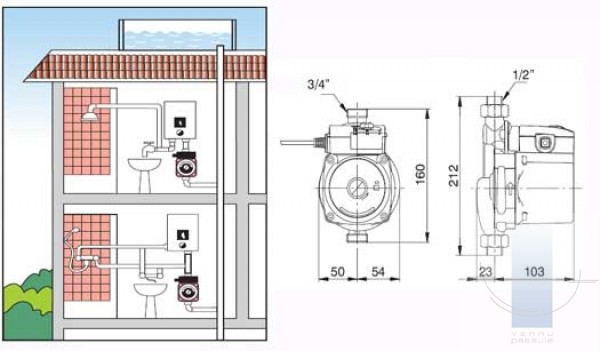
The indisputable advantages of using booster pumps include:
- the ability to work with liquids in a large temperature range;
- ease of connection and maintenance,
- light weight
- compact sizes
- low noise during operation;
- ability to constantly maintain optimal pressure in the system.
Choosing booster pumps for water supply, you should definitely think about their performance. If it’s about installing the device on common highway, there is a risk that the pump will run at full capacity, but the debit of the water will fall. In turn, this will entail rapid wear of the device and frequent repairs. In such a situation, the right step would be to install a booster pump with a storage tank. This measure will ensure the required parameters of the water pressure in the tap. The savings bank can be connected directly to the highway itself. The weak point in installing such a system is the complexity of the assembly. It is more time consuming than with the surface version. pumping station. When installing a submersible booster pump on automation, consult a specialist on how best to install membrane tank. Incorrect connection of the pressure sensor, pump motor, dry run protection system can lead to damage to the device.
In any case, prior to installing the submersible or surface pressure boosting pump, draw up a wiring diagram. If necessary, consult with a specialist. After all, improper installation is not a guarantee basis for free repair of equipment.
